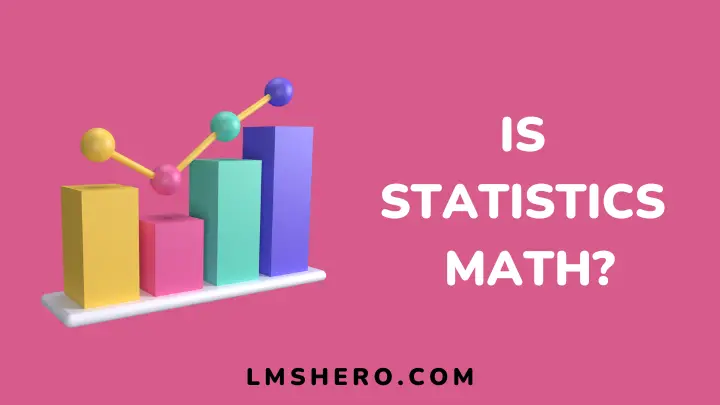Have you ever considered whether statistics and math are more like peas in a pod or distant cousins at a family reunion? You are not alone. I’m delving into the age-old topic of whether statistics is truly math.
Prepare for a delightful journey as I uncover the truth behind the statistics, graphs, and calculations. Consider this your crash course in data and probabilities.
So, whether you’re a math expert or someone who thinks numbers are a foreign language, stick around as I peel back the layers to reveal the true relationship between statistics and math. Are you prepared to dispel some myths while having a great time doing it? Let’s get started…
Is statistics math?
Statistics and mathematics have a complex but unique interaction. It is a branch of mathematics, not math itself. Statistics studies data gathering, analysis, interpretation, and presentation.
It uses mathematical techniques to extract relevant insights from large amounts of data. Statistics is essentially the art of making sense of data and trends.
Understanding the mathematical foundation of statistics
Statistics draws heavily from mathematical principles, making it an essential tool in various disciplines. Here’s a closer look at how mathematics underpins statistics:
Probability theory: the building block
Probability theory, a fundamental branch of mathematics, forms the basis of statistics. It deals with uncertainty and randomness, providing tools to quantify the likelihood of different outcomes. This enables statisticians to make informed decisions and predictions.
Descriptive statistics: summarizing data
Descriptive statistics, a cornerstone of statistics, involves summarizing and presenting data meaningfully.
This includes measures like mean, median, and mode, which help us understand the central tendencies of a data set.
These measures are calculated through mathematics, offering valuable insights into data distributions.
Inferential statistics: drawing conclusions
Inferential statistics extends its roots into mathematics by enabling us to conclude a population based on a sample.
Techniques like hypothesis testing and confidence intervals rely on mathematical calculations to determine the reliability and significance of findings.
The role of statistics in modern society
Statistics is a branch of mathematics, but it serves a much broader purpose in modern society than crunching numbers. Statistics are like a secret weapon that helps us make sense of the world around us.
It enables us to make sense of massive amounts of data and identify patterns and trends that might go unnoticed. Statistics is everywhere, from predicting election outcomes to understanding consumer behavior.
It assists corporations in making strategic decisions, governments develop policies, and researchers discover new insights. In a world where information is power, statistics enables us to comprehend the world around us and determine our future.
So, while statistics has its roots in mathematics, its significance is far-reaching and critical to our world knowledge.
Real-world applications of statistics

1. Science and research
Both mathematics and statistics play pivotal roles in scientific research. Mathematics enables scientists to develop theories and equations that explain natural phenomena. On the other hand, statistics allows them to analyze experimental results and draw valid conclusions.
2. Business and economics
Statistics guides businesses in making informed decisions. From market research to financial analysis, statistics aids in understanding consumer behavior, market trends, and risk assessment, all of which significantly impact business strategies.
3. Environmental science
Statistics is like a secret decoder for environmental scientists. It helps them make sense of all the messy data about things like climate change, pollution, and wildlife.
Imagine figuring out if the air is getting dirtier or if a certain animal species is in trouble without numbers to guide you – it’d be like navigating a dense forest without a map.
With statistics, scientists can spot trends, predict future changes, and understand how our actions affect Mother Nature. It’s like giving them a magnifying glass to see the hidden patterns in the chaos, so they can work on keeping our planet happy and healthy.
4. Sports analytics
Consider sports analytics to be the coach’s playbook driven by data. Teams and supporters can go deeper into the specifics of the game and learn more about it by using statistics.
Understanding player capabilities, team strategy, and predicting outcomes is like having a superpower. Have you ever wondered how they come up with amazing statistics like “player efficiency” or “win probabilities”?
That’s statistics in action. It’s not just about rooting for your favorite team; it’s about deciphering the meaning behind every play, shot, and victory.
So, the next time you watch a game, remember that the numbers on the screen aren’t simply random figures. They’re the key to unlocking the secrets of the sports world.
5. Social sciences
Statistics provide a significant boost to the social sciences. Understanding individuals and society is like having a magnifying glass.
Consider this: how can we know what motivates people, why they vote the way they do, or how opinions evolve?
Statistics assist researchers in gathering information from surveys and studies, then crunching the statistics to discover trends and patterns. It’s like seeing a mystery unfold in slow motion.
FAQs
Is statistics a branch of mathematics?
Statistics is an aspect of mathematics that involves data analysis and interpretation.
Can statistics exist in the absence of mathematics?
No, statistics uses mathematical methods and calculations.
Is mathematics just about numbers?
No. Mathematics is a broad field with several disciplines defining relationships, solving problems, and constructing ideas.
Can statistics be applied in everyday situations?
Yes. Statistics aids us in making educated judgments, from analyzing sports data to interpreting medical studies.
Why is the relationship between math and statistics important?
Mathematics equips statisticians with tools, allowing them to extract insights from data and draw meaningful conclusions.
Wrapping up
That’s all there is to it, guys! We’ve gone through the twists and turns of statistics and algebra, and hopefully, you now better understand their unique relationship. Statistics borrows a few moves from arithmetic, but it has its approach.
Consider them partners in crime: math gives the framework, while statistics adds realism. So, the next time you look at a graph or calculate probabilities, remember that you’re tapping into the strong combination of numbers and logic that keeps research moving.
Let’s raise a virtual glass to the dynamic duo that helps us understand our reality, one data point at a time, whether you’re a math aficionado or a statistics cynic.
You can also explore profitable careers in applied mathematics.
Thanks for reading.






